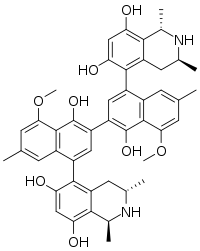Michellamine
Michellamines are a group of atropisomeric alkaloid which have been found to be HIV viral replication inhibitors in vitro. It was discovered in the leaves of Ancistrocladus korupensis.[1] There are three michellamines represented as A, B, and C; however, michellamine B is the most active against the NID-DZ strain of HIV-2.[2]
 | |
| Names | |
|---|---|
| IUPAC name
(1R,3R,1’R,3’R)-5,5’-(1,1’-dihydroxy-8,8’-dimethoxy-6,6’-dimethyl-2,2’-binaphthalene-4,4’-diyl)bis(1,3-dimethyl-1,2,3,4-tetrahydroisoquinoline-6,8-diol) | |
| Identifiers | |
3D model (JSmol) |
|
| ChemSpider | |
PubChem CID |
|
CompTox Dashboard (EPA) |
|
| |
| |
| Properties | |
| C46H48N2O8 | |
| Molar mass | 756.896 g·mol−1 |
Except where otherwise noted, data are given for materials in their standard state (at 25 °C [77 °F], 100 kPa). | |
| Infobox references | |
Occurrence
Michellamine A and B occur naturally in Ancistrocladus korupensis leaves. Other chemical substances including alkaloids, tannins, and saponins are found in the roots, leaves, stems, flowers, or bark.
Synthesis
There are two methods explored to synthesize michellamines A and B. The first one, originally synthesized in 1994, is a retrosynthesis that leads to a biomimetic pathway that uses the construction of naphthalene/isoquinoline bonds before the naphthalene/naphthalene axis. The second method, originally synthesized only a few montes after the first method, is a complementary pathway that would use the naphthalene/naphthalene axis after it is created and add the two isoquinoline moieties.[3]
Research
Michellamines inhibit protein kinase C and virus-induced cellular fusion.[4] They have a broad range of effectiveness in vitro across most HIV strains, particularly the HIV-2 strain, which is found primarily in and around Cameroon.[4]
References
- Schlauer, Jan; et al. (1 February 1998). "Characterization of Enzymes fromAncistrocladus (Ancistrocladaceae) and Triphyophyllum (Dioncophyllaceae) Catalyzing Oxidative Coupling of Naphthylisoquinoline Alkaloids to Michellamines,, ,". Archives of Biochemistry and Biophysics. 350 (1): 87–94. doi:10.1006/abbi.1997.0494. PMID 9466824.
- Zhang, Heping; Zembower, David; Chen, Zhidong (October 1997). "Structural analogues of the michellamine anti-HIV agents. Importance of the tetrahydroisoquinoline rings for biological activity". Bioorganic & Medicinal Chemistry Letters. 7 (20): 2687–2690. doi:10.1016/S0960-894X(97)10057-9.
- Bringmann, Gerhard; Götz, Roland; Keller, Paul A.; Walter, Rainer; Boyd, Michael R.; Lang, Fengrui; Garcia, Alberto; Walsh, John J.; Tellitu, Imanol; Bhaskar, K. Vijaya; Kelly, T. Ross (January 1998). "A Convergent Total Synthesis of the Michellamines". The Journal of Organic Chemistry. 63 (4): 1090–1097. doi:10.1021/jo971495m.
- White, E.; Chao, W. R.; Ross, L. J.; Borhani, D. W.; Hobbs, P. D.; Upender, V.; Dawson, M. I. (1999). "Michellamine Alkaloids Inhibit Protein Kinase C". Archives of Biochemistry and Biophysics. 365 (1): 25–30. doi:10.1006/abbi.1999.1145. PMID 10222035.